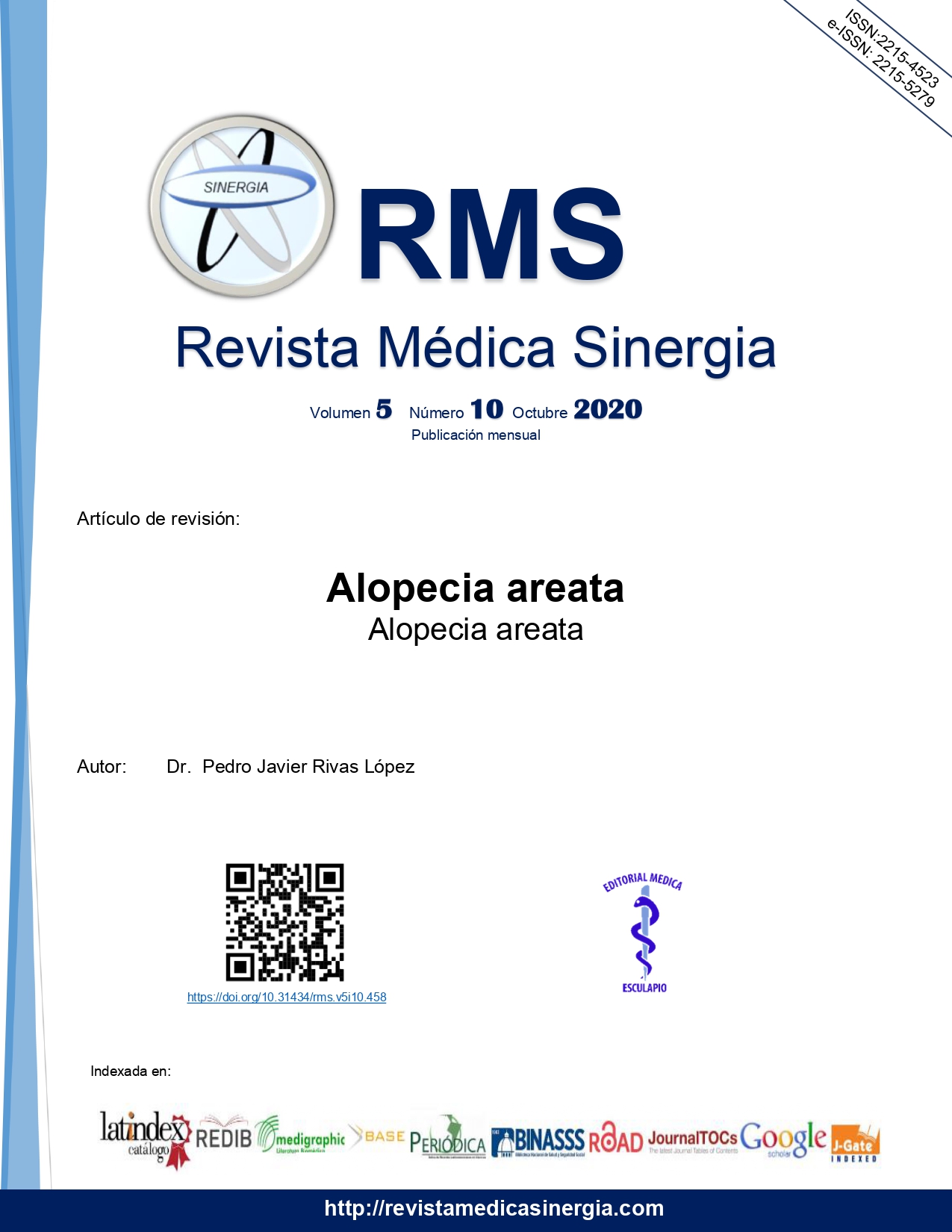Abstract
Alopecia areata is a disease of multifactorial origin in which the presence of genetic, environmental and local autoimmune factors of the hair follicle intervenes that end up causing hair loss. The clinical presentations can be diverse from the sisaifo to the alopecia universalis or alopecia totalis and although it is a benign condition, an important association has been found with other autoimmune diseases of a not so benign nature. Although all the pathophysiological pathways are unknown, clear evidence has been found of a dysregulation of the signaling pathways mediated by the Janus kinases, among others. Currently there are multiple topical and oral treatments for Alopecia Areata with variable results, Janus Kinasa inhibitors are a new therapeutic option under investigation.
References
Agrawal, Pooja. Alopecia Areata An Update. MGM Journal of Medical Sciences 2017;4(3):134-138.https://doi.org/10.5005/jp-journals-10036-1156
Blume-Peytavi, V et Vogt, A. Translational Positioning of Janus Kinase (JAK) Inhibitors in Alopecia Areata. Journal EBioMedicine 2015 (2): 282-283. https://doi.org/10.1016/j.ebiom.2015.02.015
Betz, R., Petukhova, L., Ripke, S. et al. Genome-wide meta-analysis in alopecia areata resolves HLA associations and reveals two new susceptibility loci. Nat Commun 6, 5966 (2015). https://doi.org/10.1038/ncomms6966
King, B et al. Tofacitinib for the treatment of severe alopecia areata and variants. A study of 90 patients. Journal of the American Academy of Dermatology 2017. Vol.76 No.1 :22-28. https://doi.org/10.1016/j.jaad.2016.09.007
Öztekin A, Metin A, Kirbas SC, Öztekin C.Frequency of alopecia areata in patients with autoimmune thyroid diseases.Apollo Med 2017;14:165-70. https://doi.org/10.1016/j.apme.2017.06.002
Abd El-Mawla AM, Maghrabi IA. Prevalence and treatment of Alopecia areata in Taif area, KSA. Saudi J Health Sci 2015;4:125-8. https://doi.org/10.4103/2278-0521.157891
Jabbari, A et al. Reversal of Alopecia Areata Following Treatment with the JAK 1/2 Inhibitor Baricitinib. Journal EBioMedicine 2015 (2): 351-355. https://doi.org/10.1016/j.ebiom.2015.02.015
Jabbari, A. et al. Molecular signatures define alopecia areata subtypes and transcriptional biomarkers. Journal EBioMedicine 2016 (7): 240-247. https://doi.org/10.1016/j.ebiom.2016.03.036
Lyakhovitsky A, Gilboa S, Eshkol A, Barzilai A, Baum S: Late-Onset Alopecia Areata: A Retrospective Cohort Study. Dermatology 2017;233:289-294. https://doi.org/10.1159/000481881
M. Roest, Y et al. Nail Involvement in Alopecia Areata A Questionnaire-based Survey on Clinical Signs, Impact on Quality of Life and Review of the Literature. Acta Dermato-Venereologica 2018, 98: 212-218.https://doi.org/10.2340/00015555-2810
Bin Saif, G. Severe subtype of alopecia areata is highly associated with thyroid autoimmunity. Saudi Medical Journal 2016; Vol.37 (6): 656-661. https://doi.org/10.15537/smj.2016.6.13777
Martínez-Suárez HV. Alopecia areata. Dermatol Rev Mex 2015;59:395-405. https://www.medigraphic.com/pdfs/derrevmex/rmd-2015/rmd155g.pdf
Mohan GC, Silverberg JI. Association of Vitiligo and Alopecia Areata With Atopic Dermatitis: A Systematic Review and Meta-analysis. JAMA Dermatol. 2015;151(5):522-528. https://doi.org/10.1001/jamadermatol.2014.3324
Li DG, Huang KP, Xia FD, Joyce C, Scott DA, Qureshi AA, et al. (2018) Development and pilot-testing of the Alopecia Areata Assessment Tool (ALTO). PLoS ONE 13(6): e0196517.https://doi.org/10.1371/journal.pone.0196517
Craiglow, B et al. Tofacitinib for the treatment of alopecia areata and variants in adolescents. Journal of American Academy of Dermatology 2017; 76: 29-32. https://doi.org/10.1016/j.jaad.2016.09.006
Hyun-Sun, Park et. al. Oral Tofacitinib monotherapy in Korean patients with refractory moderate-to-severe alopecia areata: A case series. Journal of the American Academy of Dermatology 2017. Vol. 77 (5) pp: 978-980. https://doi.org/10.1016/j.jaad.2017.06.027

This work is licensed under a Creative Commons Attribution-NonCommercial 4.0 International License.
Copyright (c) 2020 Array


